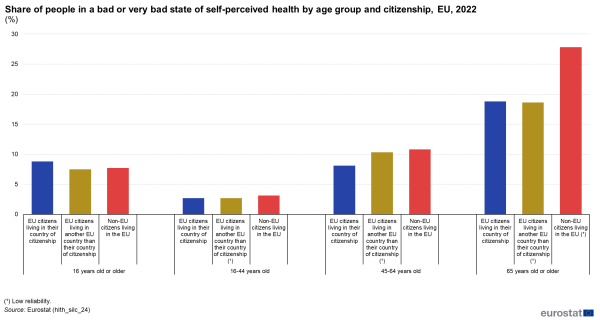Migrant integration statistics - health
Data extracted on 10 November 2023
Planned article update: September 2024
Highlights
In 2022, the self-perceived health of non-EU citizens living in the EU was less favourable than that of EU citizens living in another EU country than their country of citizenship or EU citizens living in their own country for each age group (16-44 years old, 45-64 years old and 65 years old or older), particularly for persons 65 years old or older.
This article presents an overview of the self-reported health status of non-nationals at least 16 years old and living in private households in the European Union (EU), and compares it with the self-reported health status of nationals at least 16 years old and living in private households. Non-nationals are EU citizens living in another EU country than their country of citizenship and non-EU citizens living in the EU. Nationals are EU citizens living in their country of citizenship. The first part of the article focuses on self-perceived health – one of the indicators included in the Zaragoza declaration[1] – and gives an overall assessment by respondents of their health in general. The second indicator – information on self-reported unmet medical examination or treatment needs – is also analysed, along with the information on self-reported unmet dental examination or treatment needs[2]. The information presented refers to the population aged over 16 for the most recent year available (2022). The article’s main aim is to evaluate the level of integration into the EU of non-nationals in the field of health by comparing them with nationals.
Full article
Self-perceived health
Self-perceived health is surveyed through a question about how a person perceives their health in general, using one of the following answer categories: very good, good, fair, bad or very bad. It refers to a person’s health in general rather than their present (perhaps temporary) state of health and concerns physical, social and emotional functions and biomedical signs and symptoms. The analysis only focuses in this part on the aggregated category bad/very bad and applies to four age groups (16 years old or older, 16-44 years old, 45-64 years old and 65 years old or older).

(%)
Source: Eurostat (hlth_silc_24)
For the total surveyed population (16 years old or older), Table 1 shows that at EU level in 2022 the share of nationals living in their own country (8.8 %) in a bad or very bad state of self-perceived health was higher than for non-nationals (7.5 % for EU citizens living in another EU country and 7.7 % for non-EU citizens). However, this result to a large extent reflects the different age structures of nationals and non-nationals. On average, non-nationals living in private households in the EU are younger than nationals, whereas the highest share of people in a bad or very bad state of self-perceived health is among people 65 years old or older.This means that complementary analysis by age group is necessary to compare the health of non-nationals with that of nationals. Assuming a bad or very bad state of self-perceived health generates more medical needs, analysis of the population 16 years old or older could shed light on the provision of health services to non-nationals in comparison to nationals. Analysis by age group also provides a more accurate comparison between the self-perceived health of non-nationals and of nationals.
The four scatter plots below (Figures 1.a to 1.d) show for each age group (16 years old or older, 16-44 years old, 45-64 years old, and 65 years old or older) the ratio between the share of non-nationals and the share of nationals in a bad or very bad state of self-perceived health in 2022. This ratio is calculated separately for EU citizens living in another EU country and non-EU citizens residing in the EU. By definition, the ratio for nationals is equal to 1. A ratio higher than 1 indicates worse self-perceived health of each citizenship group than of nationals.
At EU level in 2022, the ratio for the two citizenship groups was lower than 1 only for the age group 16 years old or older due to the above-mentioned differences in the age structure of these groups. Among the three other age groups, the ratio was higher or equal to 1 except for the value observed for EU citizens living in another EU country aged 65 years or more.
When looking closely at the values of the ratio for EU citizens living in another EU country, those aged 45-64 years old perceive their health to be worse than nationals (the ratio equals 1.27). For the age group 16-44 years old, the ratio was equal. For those aged 65 years or more, the ratio was 0.99, indicating a slightly better self-perceived health than that of nationals. For non-EU citizens, the self-perceived health of all three age groups (16-44 years old, 45-64 years old and 65 years old or older) appears to be significantly worse than that of nationals (the ratios equal respectively 1.15, 1.33 and 1.48).
Those characteristics at EU level are not however shared by all the EU countries. On the scatter plots, the lines in dark bold indicate a ratio equal to 1 and separate the graph into four areas. For example, the upper right area shows Member States where both citizens of other EU countries and non-EU citizens have a worse self-perception of their health than nationals.
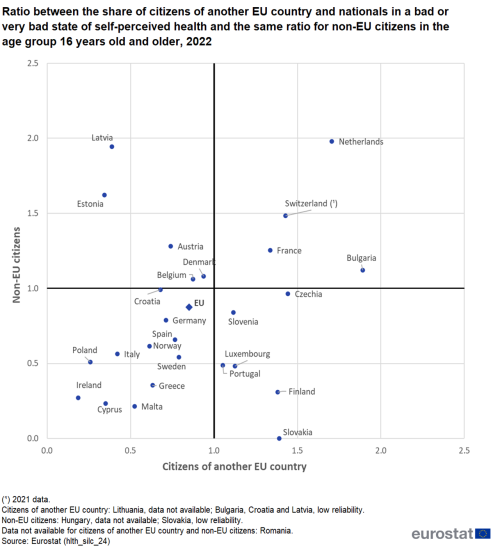
Source: Eurostat (hlth_silc_24)
For the entire surveyed population (Figure 1.a), non-EU citizens’ self-perception of health was worse than nationals’ in eight Member States, with the highest ratio recorded in the Netherlands and Latvia. For citizens of other EU countries, the ratio was higher than 1 also in eight Member States with reliable data, with the highest values recorded in the Netherlands and Czechia. Only in two EU countries (the Netherlands and France), did both citizens of other EU countries and non-EU countries 16 years old or older have a worse self-perception of their health than nationals in 2022.
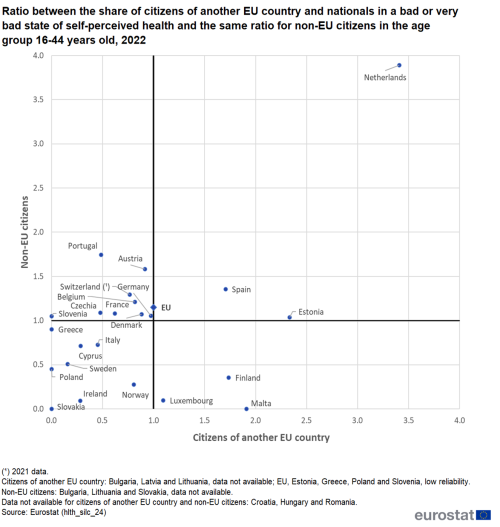
Source: Eurostat (hlth_silc_24)
Unlike the pattern observed at EU level, the self-perceived health of nationals was worse than that of both citizens of other EU countries and non-EU countries in four Member States with reliable data for the age group 16-44 years old (Figure 1.b), and in three Member States with reliable data for the age group 45-64 years old (Figure 1.c). Still, for the age group 45-64 years old, the self-perceived health of non-EU citizens was more than two times worse than that of nationals in three Member States (Czechia, Austria and Slovenia), whereas the self-perceived health of citizens other EU countries was more than two times worse than that of nationals in Portugal and Finland.
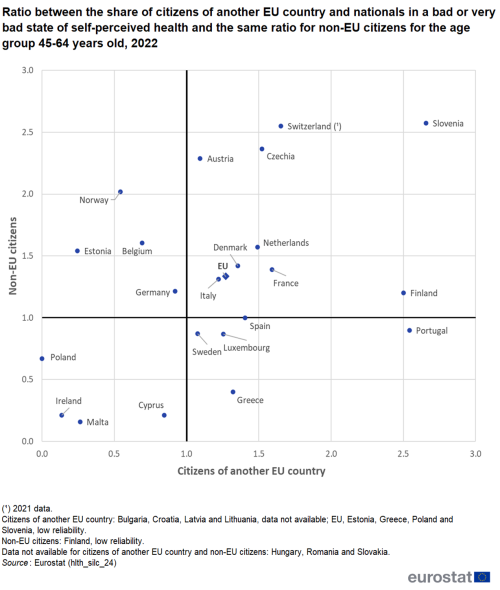
Source: Eurostat (hlth_silc_24)
Lastly, the self-perceived health of nationals was worse than that of both citizens of other EU countries and non-EU countries in only three Member States with reliable data for the age group 65 years old or older (Figure 1.d). Non-EU citizens’ self-perception of health was worse than nationals’ in four Member States with reliable data, with the highest ratio recorded in Austria and France. For citizens of other EU countries, the ratio was higher than 1 also in four Member States with reliable data, with the highest values recorded in Belgium and Czechia.
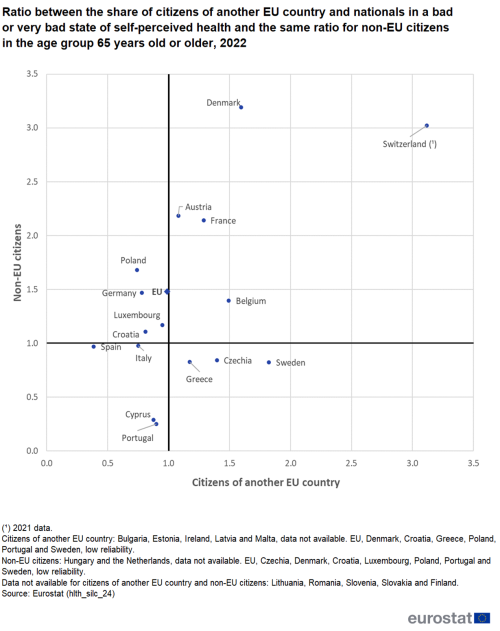
Source: Eurostat (hlth_silc_24)
Unmet medical and dental examination or treatment needs
Self-reported unmet needs are a person’s own assessment of whether they needed examination or treatment for a specific health matter but did not get or seek it. Medical care refers to individual healthcare services (medical examination or treatment excluding dental care) provided by or under the direct supervision of medical doctors or equivalent professionals according to national healthcare systems.

(%)
Source: Eurostat (hlth_silc_30) and (hlth_silc_32)
In Table 2, the comparison at EU level of self-reported unmet needs between non-nationals and nationals shows that for medical care, the share of unmet needs was the lowest for EU citizens living in another EU country (3.5 %), compared with 4.1 % observed for nationals living in their own country and 4.7 % for non-EU citizens residing in the EU. In the case of dental dental, the share of unmet needs was equal to 5.2 % for citizens of other EU Member States and 7.2 % for non-EU citizens compared with 4.8 % for nationals. The self-reported unmet medical or dental examination or treatment needs of non-EU citizens were greater than those of EU citizens living in another EU country, by 1.2 and 2.0 percentage points respectively.
To get a better picture of the integration of non-nationals at country level, Figures 2.a and 2.b show in a scatter plot the ratio between the unmet medical and dental examination or treatment needs of citizens of other EU countries and non-EU citizens and those of nationals. A ratio higher than 1 indicates less integration of non-nationals than nationals.
Of the 22 Member States for which the ratio is available for both citizens of other EU countries and non-EU citizens, the ratio of self-reported unmet needs for medical care (Figure 2.a) is higher than 1 for citizens of other EU Member States in 11 Member States with reliable data and for non-EU citizens in 16 Member States with reliable data, while both values were higher than 1 in nine Member States with reliable data. As Figure 2.b shows, the ratio of self-reported unmet needs for dental care was higher than 1 for both citizens of other EU Member States and for non-EU citizens in 11 Member States with reliable data.

Source: Eurostat (hlth_silc_30)
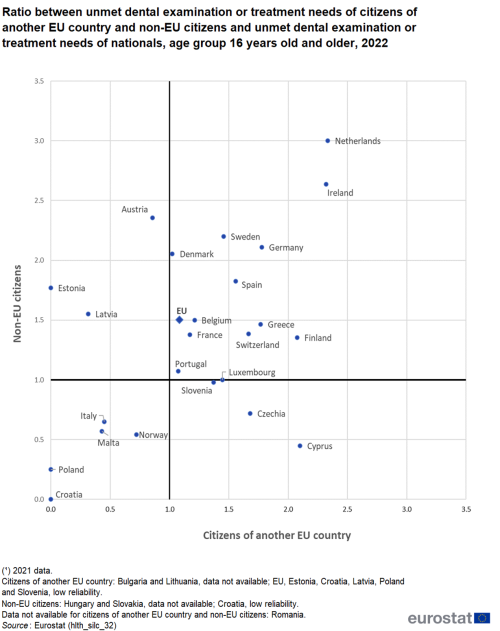
Source: Eurostat (hlth_silc_32)
Source data for tables and graphs
Data sources
The data used in the article concerning self-perceived health and unmet needs for health care are derived from EU statistics on income and living conditions (EU-SILC). This source is documented in more detail in this background article which provides information on the scope of the data, its legal basis, the methodology employed, as well as related concepts and definitions.
Data refer to the population aged 16 years or over.
The indicators presented in this article are derived from self-reported data so they are, to a certain extent, affected by respondents’ subjective perception as well as by their social and cultural background. Despite their subjective nature, the statistics that are presented are relevant and reliable estimators of the health status of populations as well as good predictors of health care needs; they are useful for trend analysis and for measuring socioeconomic disparities.
EU-SILC do not cover the institutionalised population, for example, people living in health and social care institutions whose health status is likely to be worse than that of the population living in private households. It is therefore likely that, to some degree, both data sources under-estimate health problems. Another factor that may influence the results shown is the different organisation of health care services, be that nationally or locally. Furthermore, the indicators presented are not age-standardised and thus reflect the current national age structures. Finally, the implementation of EU-SILC was organised nationally, which may impact on the results presented, for example, due to differences in the formulation of questions or their precise coverage.
Note on tables
When 0 with decimal places is displayed, values are not significant.
Context
Good health is an asset. It is not only of value to the individual as a major determinant of quality of life, well-being and social participation, but it also contributes to general social and economic growth. Many factors influence the health status of a population and these can be addressed by health and other policies regionally, nationally or across the EU.
Indicators on health status are given high importance in EU health policies. The monitoring of health status of populations was included in the overarching EU strategy 'Together for Health: A Strategic Approach for the EU 2008-2013' (COM(2007) 630 final) and in the more recent 'Investing in health' working document. Health status monitoring is also important for more topical policies such as active and healthy ageing, health inequalities and social protection and social inclusion.
Moreover, the EU’s active inclusion strategy aims to ensure that every citizen, including the most disadvantaged, may fully participate in society, through the provision of adequate income support, inclusive labour markets and access to quality services, including healthcare. Since the signature of the Treaty of Lisbon in 2007, European institutions have the mandate to ‘provide incentives and support for the action of Member States with a view to promoting the integration of third-country nationals.’ In June 2016, the European Commission published an Action plan on the integration of third country nationals (COM(2016) 377 final) which set out a range of goals, providing a comprehensive framework to support EU Member States’ efforts in developing and strengthening their integration policies, for example, in the fields of education, employment and vocational training, access to basic services such as housing and healthcare, as well as active participation and social inclusion. The latter includes initiatives, among others, to promote the use of EU funds for: intercultural dialogue, cultural diversity and common values; active participation of third country nationals in political, social and cultural life; activities dedicated to ensuring the integration of refugees and asylum seekers; preventing and combating discrimination, racism and xenophobia.
Building on progress made since 2016, a new pact on migration and asylum was presented by the European Commission in September 2020. This sought to provide new tools for faster and more integrated procedures, a better management of Schengen and borders, as well as flexibility and crisis resilience. The new pact on migration and asylum, sets out a fairer, more European approach to managing migration and asylum. It aims to put in place a comprehensive and sustainable policy, providing a humane and effective long-term response to the current challenges of irregular migration, developing legal migration pathways, better integrating refugees and other newcomers, and deepening migration partnerships with countries of origin and transit for mutual benefit.
In November 2020, an Action plan on Integration and Inclusion 2021-2027 (COM(2016) 377 final) was adopted. It seeks to detail targeted and tailored support to reflect the individual characteristics that may present specific challenges to people with a migrant background, such as gender or religious background.
Direct access to
- Health (mii_health)
- Health status (mii_hlth_state)
- Health determinants (mii_hlth_det)
- Health care (mii_hlth_care)
- Legal migration and integration
- New pact on migration and asylum
- European Commission — study on active inclusion of migrants, IZA and ESRI, 2011
- European Commission — the 2010 Zaragoza declaration
- European Commission — Using EU Indicators of Immigrant Integration — final report of the European Services Network (ESN) and the Migration Policy Group (MPG) (PDF)
- European Website on Integration
- ILO — labour migration
- Indicators of immigrant integration 2023 - Settling in
Notes
- ↑ A set of common indicators agreed by EU Member States. See the declaration of the European ministerial conference on integration, Zaragoza, 15-16 April 2010.
- ↑ The additional indicators, allowing for a better assessment of the health of non-nationals, have been suggested for monitoring the integration of migrants in a 2013 report titled Using EU indicators of immigrant integration.
